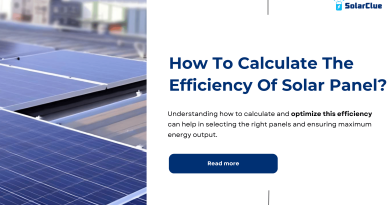What Are Solar Cells? Explain The Structure Of Solar Panel?
Solar cells are the fundamental building blocks of solar panels, which convert sunlight into electricity. This guide will explore the structure, function, and types of solar cells, including how they work, the materials used, and their impact on renewable energy.
Table of Contents
- 1 The Photovoltaic Effect and How It Works
- 2 The Structure of a Solar Cell
- 3 Different Types of Solar Cells and Their Characteristics
- 4 The Efficiency of Different Solar Cell Types
- 5 The Role of Solar Cells in Solar Panels
- 6 The Future of Solar Cell Technology
- 7 Common Misconceptions About Solar Cells
- 8 The Impact of Solar Cell Technology on Renewable Energy
- 9 Case Studies of Innovative Solar Cell Advancements
- 10 Table: Comparison of Different Types of Solar Cells
- 11 FAQ Section
- 12 Conclusion
The Photovoltaic Effect and How It Works
1. What Is the Photovoltaic Effect?
-
- Definition: The photovoltaic effect is the process by which a solar cell converts sunlight into electricity. When sunlight strikes a solar cell, photons (light particles) are absorbed by the semiconductor material, knocking electrons loose from their atoms and creating an electric current.
- Energy Conversion: The photovoltaic effect is the basis for how solar cells generate direct current (DC) electricity, which can then be used to power electrical devices or be converted to alternating current (AC) for use in homes and businesses.
2. How It Works
-
- Photon Absorption: When sunlight hits the solar cell, its energy is absorbed by the semiconductor material (usually silicon). This energy excites electrons, freeing them from their atomic bonds.
- Electron Movement: The freed electrons move towards the front surface of the cell, creating an electric current as they flow through an external circuit.
- Electric Field: The solar cell’s built-in electric field, created by the junction of two types of semiconductor material (p-type and n-type), drives the movement of electrons, ensuring they flow in the right direction.
The Structure of a Solar Cell
1. Layers of a Solar Cell
-
- Front Contact: The front contact layer allows light to pass through while collecting the electrons released by the photovoltaic effect. It’s typically made of a fine metal grid.
- Anti-Reflective Coating: This layer reduces the reflection of sunlight off the cell’s surface, allowing more light to be absorbed by the semiconductor material.
- Semiconductor Material: The most critical layer, usually made of silicon, where the photovoltaic effect occurs. This layer consists of two types of silicon: p-type (positive) and n-type (negative), which create the electric field.
- Back Contact: The back contact layer collects the electrons and completes the circuit, allowing electricity to flow out of the cell to be used or stored.
2. Materials Used in Solar Cells
-
- Silicon: The most common material used in solar cells, known for its effectiveness in converting sunlight to electricity. Silicon can be found in different forms, such as monocrystalline, polycrystalline, and amorphous (thin-film).
- Cadmium Telluride (CdTe): Used in thin-film solar cells, CdTe is a cost-effective alternative to silicon but with lower efficiency.
- Copper Indium Gallium Selenide (CIGS): Another material used in thin-film solar cells, known for its flexibility and higher efficiency compared to CdTe.
Different Types of Solar Cells and Their Characteristics
1. Monocrystalline Solar Cells
-
- Structure: Made from a single crystal structure, monocrystalline cells are cut from a cylindrical silicon ingot, resulting in a uniform and pure material.
- Efficiency: These cells are the most efficient, with efficiency ratings typically between 17% and 22%.
- Advantages: High efficiency, long lifespan, and good performance in low-light conditions.
- Disadvantages: More expensive due to the manufacturing process and material purity.
2. Polycrystalline Solar Cells
-
- Structure: Made from silicon crystals that are melted together, polycrystalline cells have a multi-crystalline structure with visible grain boundaries.
- Efficiency: Slightly lower efficiency than monocrystalline, usually between 15% and 18%.
- Advantages: Lower cost due to a simpler manufacturing process.
- Disadvantages: Lower efficiency and slightly larger surface area required for the same power output.
3. Thin-Film Solar Cells
-
- Structure: Made by depositing one or more layers of photovoltaic material (such as CdTe, CIGS, or amorphous silicon) onto a substrate like glass, plastic, or metal.
- Efficiency: Lower efficiency, typically between 10% and 12%, but can vary depending on the material used.
- Advantages: Lightweight, flexible, and can be produced at a lower cost.
- Disadvantages: Requires more surface area to generate the same amount of power, shorter lifespan, and lower efficiency.
4. Bifacial Solar Cells
-
- Structure: Bifacial solar cells are designed to capture sunlight on both the front and back sides of the panel, making use of reflected light from the ground or surrounding surfaces.
- Efficiency: Higher overall energy output due to dual-sided light absorption.
- Advantages: Increased energy production, especially in environments with high albedo (reflective surfaces).
- Disadvantages: Higher cost and requires careful installation to maximize reflected light.
The Efficiency of Different Solar Cell Types
1. Efficiency Ratings
-
- Monocrystalline: 17% – 22% (highest efficiency)
- Polycrystalline: 15% – 18% (moderate efficiency)
- Thin-Film: 10% – 12% (lower efficiency)
- Bifacial: Varies, but can achieve higher total output due to dual-sided absorption.
2. Factors Affecting Efficiency
-
- Material Purity: Higher purity materials, like those used in monocrystalline cells, generally offer higher efficiency.
- Cell Design: Advanced designs, such as passivated emitter and rear cell (PERC) technology, can enhance efficiency by reducing energy losses.
- Environmental Conditions: Temperature, light intensity, and shading can impact the efficiency of solar cells.
The Role of Solar Cells in Solar Panels
1. Connecting Solar Cells
-
- Series and Parallel Configurations: Solar cells are connected in series to increase voltage and in parallel to increase current. This configuration allows the solar panel to produce the desired power output.
- Encapsulation: Solar cells are encapsulated within a protective layer (usually glass) to shield them from environmental damage while allowing sunlight to pass through.
2. Power Generation
-
- Conversion to Usable Power: The electricity generated by solar cells is in the form of DC power, which is then converted to AC power by an inverter for use in homes and businesses.
- System Integration: Solar panels, composed of multiple solar cells, are integrated into larger systems that may include batteries, inverters, and monitoring equipment to provide a stable and reliable power source.
The Future of Solar Cell Technology
1. Emerging Technologies
-
- Perovskite Solar Cells: These cells promise higher efficiency and lower production costs, with efficiencies already reaching over 25% in lab settings.
- Tandem Solar Cells: By stacking different materials, tandem cells can capture a broader spectrum of sunlight, potentially increasing efficiency to over 30%.
- Organic Photovoltaics (OPV): OPVs offer flexibility and lightweight solutions, though currently with lower efficiency and shorter lifespan.
2. Innovations in Materials
-
- Quantum Dots: Quantum dot technology could lead to highly efficient solar cells by tuning the absorption spectrum to capture more sunlight.
- Transparent Solar Cells: These cells could be integrated into windows and other surfaces, allowing for energy generation without obstructing views.
Common Misconceptions About Solar Cells
1. Myth: Solar Cells Are Inefficient and Not Worthwhile
-
- Reality: Modern solar cells have seen significant efficiency improvements, with commercial panels achieving up to 22% efficiency. While not 100% efficient, they provide a sustainable and cost-effective energy solution.
2. Myth: Solar Panels Require Constant Direct Sunlight
-
- Reality: While direct sunlight is ideal, solar cells can still generate electricity in cloudy or shaded conditions, albeit at reduced efficiency.
3. Myth: All Solar Cells Are the Same
-
- Reality: There are multiple types of solar cells, each with different characteristics, efficiencies, and applications. Choosing the right type depends on specific needs and environmental conditions.
The Impact of Solar Cell Technology on Renewable Energy
1. Global Energy Transformation
-
- Contribution to Clean Energy: Solar cell technology has played a crucial role in reducing dependence on fossil fuels, contributing to a global shift towards renewable energy.
- Scalability: Solar cells can be scaled from small residential installations to large solar farms, providing flexibility in energy production.
2. Economic Benefits
-
- Cost Reduction: As solar cell technology advances, the cost of solar energy continues to decrease, making it more accessible to a broader population.
- Job Creation: The growth of the solar industry has created millions of jobs worldwide, from manufacturing and installation to research and development.
3. Environmental Impact
-
- Reduction in Carbon Emissions: By replacing fossil fuel-based energy sources, solar cells help reduce greenhouse gas emissions, mitigating climate change.
- Sustainable Development: Solar energy supports sustainable development goals by providing clean, reliable, and affordable energy.
Case Studies of Innovative Solar Cell Advancements
1. Perovskite Solar Cells
-
- Innovation: Researchers have developed perovskite solar cells with efficiency levels surpassing 25%, demonstrating their potential as a low-cost, high-efficiency alternative to silicon-based cells.
- Impact: These cells could revolutionize the solar industry by offering a more affordable solution with higher efficiency.
2. Tandem Solar Cells
-
- Innovation: Tandem cells, combining silicon with perovskite or other materials, have achieved efficiencies over 30% in lab settings.
- Impact: This technology has the potential to significantly increase the energy output of solar panels, making solar power more competitive with traditional energy sources.
3. Bifacial Solar Panels
-
- Innovation: Bifacial panels capture sunlight on both sides, increasing total energy production by up to 20% compared to traditional monofacial panels.
- Impact: These panels are particularly effective in environments with high albedo, such as snowy regions, where they can capture reflected sunlight.
Table: Comparison of Different Types of Solar Cells
| Solar Cell Type | Efficiency | Cost | Durability | Advantages | Disadvantages |
|---|---|---|---|---|---|
| Monocrystalline | 17% – 22% | High | High | High efficiency, good low-light performance | More expensive, more waste in manufacturing |
| Polycrystalline | 15% – 18% | Moderate | Moderate | Lower cost, easier to manufacture | Lower efficiency, larger surface area needed |
| Thin-Film | 10% – 12% | Low | Moderate | Lightweight, flexible, lower cost | Lower efficiency, requires more space |
| Bifacial | 17% – 22%+ | High | High | Higher energy production, dual-sided absorption | More expensive, requires optimal placement |
| Perovskite | 20% – 25%+ | Moderate | TBD | High efficiency, low cost potential | Stability and scalability challenges |
FAQ Section
-
- What is the difference between monocrystalline and polycrystalline solar cells?
- Monocrystalline solar cells are made from a single crystal structure, offering higher efficiency and better performance in low-light conditions. Polycrystalline cells are made from multiple silicon crystals, resulting in slightly lower efficiency but at a lower cost.
- How do thin-film solar cells compare to traditional silicon-based cells?
- Thin-film solar cells are lightweight, flexible, and cheaper to produce but have lower efficiency compared to monocrystalline and polycrystalline cells. They are ideal for applications where flexibility and weight are more important than efficiency.
- Can solar cells generate electricity on cloudy days?
- Yes, solar cells can still generate electricity on cloudy days, but at reduced efficiency. The amount of power generated depends on the intensity of the diffused sunlight.
- What advancements are expected in solar cell technology?
- Future advancements include the development of high-efficiency tandem cells, the commercialization of perovskite solar cells, and the integration of solar cells into more applications through flexible and transparent technologies.
- How do solar cells contribute to reducing carbon emissions?
- Solar cells generate clean, renewable energy by converting sunlight into electricity without emitting greenhouse gases, helping to reduce carbon emissions and combat climate change.
- What is the difference between monocrystalline and polycrystalline solar cells?
Conclusion
Solar cells are at the heart of solar energy technology, driving the transition to a cleaner, more sustainable energy future. Understanding the different types of solar cells, their advantages and disadvantages, and the ongoing advancements in the field is crucial for making informed decisions about solar power. As technology continues to evolve, solar cells will play an increasingly important role in global energy production, offering efficient, affordable, and environmentally friendly solutions for our energy needs.



